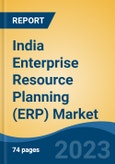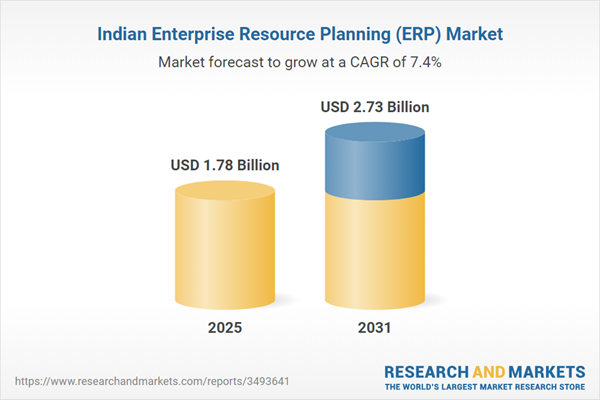Speak directly to the analyst to clarify any post sales queries you may have.
10% Free customizationThis report comes with 10% free customization, enabling you to add data that meets your specific business needs.
Key Market Drivers
Digital Transformation and Legacy System Modernization
India’s ERP market is being driven by the widespread digital transformation initiatives reshaping enterprise operations across sectors. Companies are retiring outdated, siloed legacy systems in favor of integrated ERP platforms that provide real-time insights and cross-functional alignment. Modern ERP systems consolidate critical processes - finance, HR, procurement, inventory - into a single platform, eliminating manual inefficiencies and promoting informed decision-making.Legacy infrastructures often hinder agility and growth, making modern ERP systems crucial for businesses aiming to scale and adapt in dynamic environments. These platforms also support regulatory compliance and faster financial reporting. For instance, businesses implementing ERP have reported up to 35% reductions in financial closing periods, resulting in enhanced cash flow visibility, better audit preparedness, and improved strategic planning. ERP adoption is thus a cornerstone of digital modernization, enabling Indian enterprises to remain competitive and future-ready.
Key Market Challenges
Complex and Fragmented Implementation Across Indian Enterprises
A major challenge in India’s ERP market is the difficulty of implementation across a heterogeneous enterprise landscape. The diversity of operational structures, legacy technologies, and digital readiness among businesses - particularly MSMEs in tier-2 and tier-3 cities - complicates deployment. ERP adoption often requires comprehensive organizational change, not just software integration, which smaller firms may struggle to manage due to limited IT expertise and internal resistance. Challenges such as delayed rollouts, underutilization of features, and cost overruns are common when enterprises lack proper training and change management strategies. Resistance from stakeholders, fear of disruption, and unclear understanding of ERP benefits further hinder smooth transitions. This fragmentation in readiness and execution slows down broader adoption and reduces the effectiveness of ERP investments across the Indian market.Key Market Trends
Accelerated Shift Toward Cloud-Based and Mobile ERP Solutions
The Indian ERP market is witnessing a rapid migration from traditional on-premise systems to cloud-based and mobile ERP solutions. Cloud ERP platforms offer scalability, reduced infrastructure costs, real-time access, and automated updates, making them particularly attractive to small and mid-sized businesses with limited IT resources. With growing internet penetration and improved digital infrastructure, cloud ERP is emerging as the preferred choice for new implementations.In parallel, mobile ERP applications are gaining traction by enabling access to critical business functions such as sales tracking, inventory monitoring, and financial reporting from any location. These solutions are instrumental in supporting hybrid and remote work models and empower field teams across industries like logistics, retail, and construction. The convergence of mobile and cloud ERP is helping enterprises improve operational agility, streamline workflows, and achieve faster return on investment in an increasingly digital business environment.
Key Market Players
- SAP SE
- Oracle Corporation
- Microsoft Corporation
- Infor
- Ramco Systems Ltd.
- Tally Solutions Pvt. Ltd.
- Zoho Corporation
- Epicor Software Corporation
Report Scope:
In this report, the India Enterprise Resource Planning (ERP) Market has been segmented into the following categories, in addition to the industry trends which have also been detailed below:India Enterprise Resource Planning (ERP) Market, By Component:
- Software
- Services
India Enterprise Resource Planning (ERP) Market, By Deployment Type:
- On-Premises
- Cloud
India Enterprise Resource Planning (ERP) Market, By Function:
- Finance
- Human Resource
- Customer Management
- Inventory Management
- Supply Chain
- Others
India Enterprise Resource Planning (ERP) Market, By Enterprise:
- Large Enterprise
- SMEs
India Enterprise Resource Planning (ERP) Market, By Region:
- South India
- North India
- West India
- East India
Competitive Landscape
Company Profiles: Detailed analysis of the major companies present in the India Enterprise Resource Planning (ERP) Market.Available Customizations:
With the given market data, the publisher offers customizations according to a company's specific needs. The following customization options are available for the report.Company Information
- Detailed analysis and profiling of additional market players (up to five).
This product will be delivered within 1-3 business days.
Table of Contents
Companies Mentioned
- SAP SE
- Oracle Corporation
- Microsoft Corporation
- Infor
- Ramco Systems Ltd.
- Tally Solutions Pvt. Ltd.
- Zoho Corporation
- Epicor Software Corporation
Table Information
| Report Attribute | Details |
|---|---|
| No. of Pages | 85 |
| Published | June 2025 |
| Forecast Period | 2025 - 2031 |
| Estimated Market Value ( USD | $ 1.78 Billion |
| Forecasted Market Value ( USD | $ 2.73 Billion |
| Compound Annual Growth Rate | 7.3% |
| Regions Covered | India |
| No. of Companies Mentioned | 8 |









